Elderflower season is an exciting but short lived time. Every year I try to find some way to preserve the elderflower harvest so that I can enjoy them for a longer period of time. I’ve been wanting to try making elderflower liqueur (also known as St. Germain) for some time now. This year the local elder trees were absolutely loaded with elderflowers, so I decided to make this delicious elderflower liqueur!
Harvesting Elderflowers
Elderflowers appear before elderberries, and they arrive anytime between May through July, depending on your location and climate.
It’s important to consider that elderflowers turn into elderberries, so taking them will mean fewer berries on the tree. This usually isn’t an issue as elder trees are widespread and very prolific.
Regardless, do try and only take a few flowers from each tree if possible.
Read my post on foraging elderflowers and elderberries to learn more.
Insects love elderflowers, so be sure to give the flowers a few shakes before using to remove them. It also helps to let them sit for an hour or two outside to let any remaining bugs vacate.
The leaves, stems, seeds, and unripe berries of elder are toxic when consumed in large amounts, so remember that when making any kind of elderflower or elderberry preparation.
How to Make Elderflower Liqueur
Depending on the size of the elderflowers you collect, you will need about 20-30 whole flower heads for this liqueur recipe.
Although it’s a bit labor intensive, it’s important to cut the flowers off with as little stem as possible attached. This is because the stems contain a toxic compound and can cause stomach upset in large amounts in some people.
If you don’t have access to fresh elderflowers, dried elderflowers can also be used, just use about half as much as fresh.
Fill a quart jar with the elderflowers, leaving an inch or two of space at the top.
Pour a 750ml bottle of vodka over the elderflowers, then top the jar with lemon slices to keep the flowers submerged under the vodka.
Cover the jar with a lid and put it in a cool and dark place to infuse for 2-4 weeks.
When ready to use, strain out the elderflowers with a fine mesh sieve, then add the optional honey or sugar and stir well or shake to combine.
The elderflower liqueur can be consumed right away, or aged longer if desired. It will keep indefinitely!
Elderflower Liqueur Cocktail Recipes
Can I tell you how amazing this elderflower liqueur is? It is so incredibly good, and it makes a great summer cocktail! I like to simply combine it with some sparkling mineral water, and in my opinion that’s all you really need.
If you want to get more fancy than that, here are some amazing sounding elderflower liqueur cocktail recipes to try:
- Elderflower Martini
- Elderflower Margarita
- Peach and Elderflower Sangria
- St. Germain Lavender Gin and Tonic
- Blackberry Elderflower Cocktail
Now you’re all set for summertime cocktail parties!
Enjoy the elderflower liqueur (I know you will)!
More Elderflower Recipes
Want to do more with your elderflower harvest? Here are 20+ Elderflower Recipes for cordial, liqueur, tea, jelly, cake + more!
Elderflower Liqueur
Equipment
Ingredients
- 20-30 fresh elderflowers (dried elderflowers will also work)
- 750 ml bottle vodka
- 3 slices lemon
- 1/4-1/2 cup honey or sugar (optional)
Instructions
- Cut the elderflowers off the stem into a quart sized jar until it is almost full.
- Pour the bottle of vodka over the elderflowers, then top with the slices of lemon to keep the flowers under the vodka.
- Cover the jar with a lid and put it in a cool and dark place for 2-4 weeks.
- Strain out the elderflowers with a fine mesh sieve, then add the optional honey or sugar and stir well or shake to combine.
- It can be consumed right away or aged longer if desired. It will keep indefinitely.

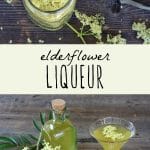
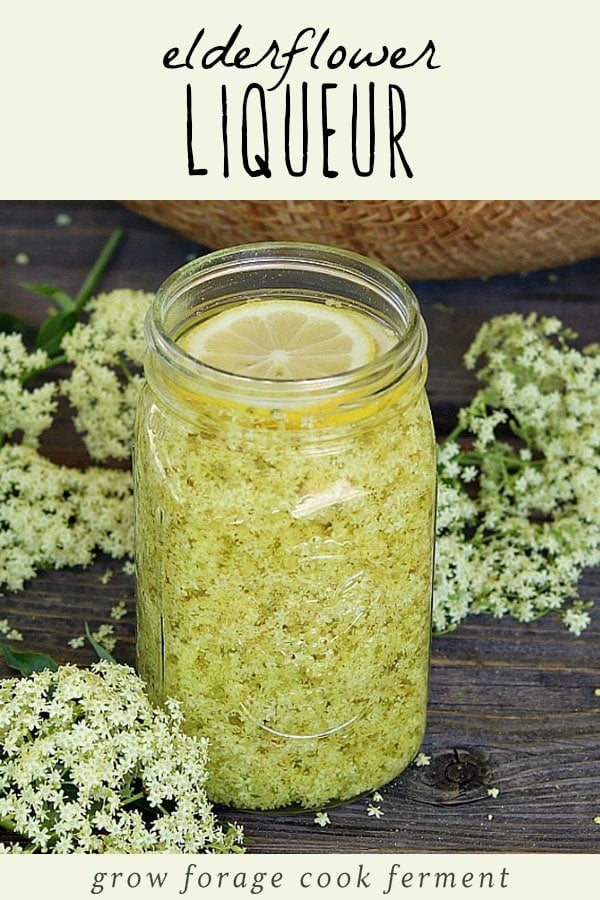

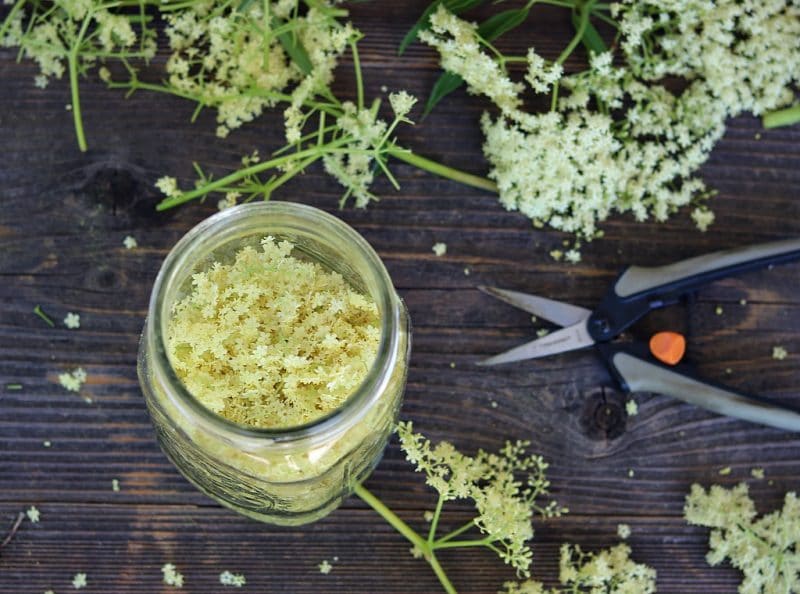
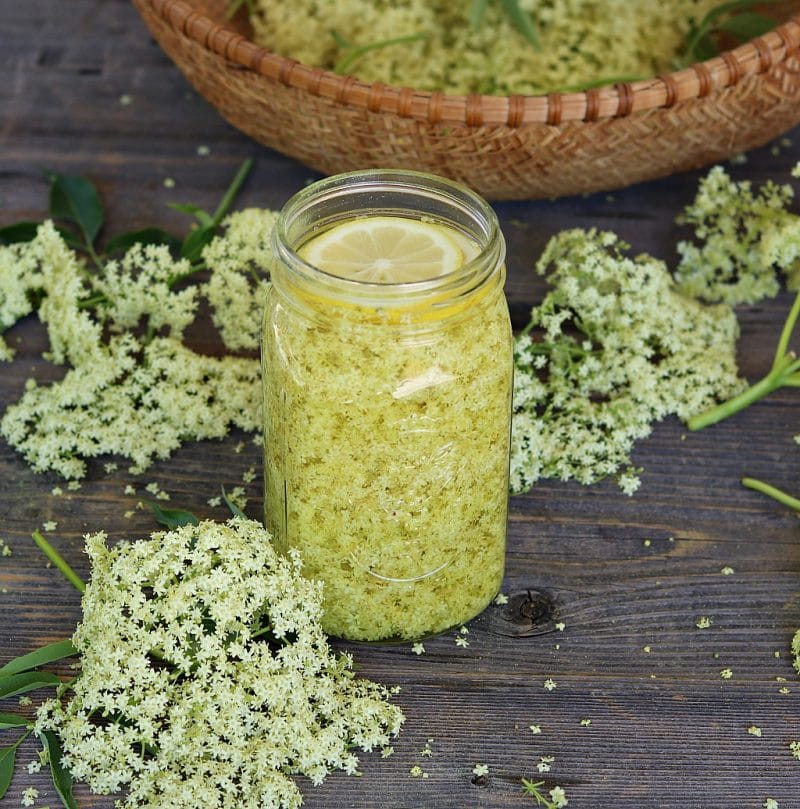
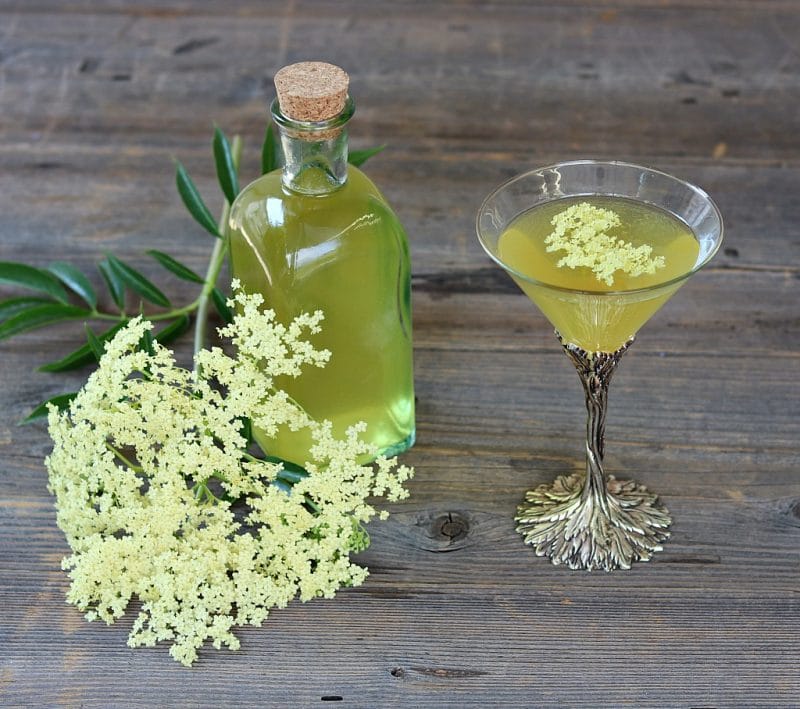
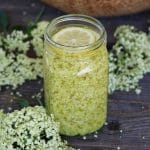

I just strained my batch and it smells and tastes great! Should this be refrigerated? Also, if I add honey does it need refrigeration? Thanks!
Hi Nancy. No, it doesn’t need to be refrigerated, even with honey.
Some of my flowers were a little darker.
So mine came out brown.
It smells strong but tastes ok.
Think it is ok to mix in a drink?
Yes, as long as it smells okay!
Hello
I left my liquor aging for 4 months
Is it ruined now?
I just forgot about it and not sure If I should bother straining it now.
Thanks
As long as there’s no mold and smells good, it should be fine.
Do you wash the elderflowers first? Or trust the vodka kills everything? It’s been so dry here. I just didn’t know if I should rinse the dust, and maybe bugs off?? Thanks!
Hi Kelsey. I personally don’t wash them. If you want to rinse gently with water, that’s fine. Just make sure most of the water is dried off before starting your infusion.
I watched the Instagram video and went ahead and added honey to the infusion right away- have I ruined it? Have I wasted these resources? I surely hope not!
This hasn’t happened to me, but I think it should be fine. I would check on it periodically over the next few weeks to make sure the honey isn’t getting funky.
Ahhh I’ve just done exactly the same. Did it turn out ok? Thanks!
If using dried elderflower, what is the amount?
I would probably use 3/4 of the recommended fresh elderflowers in the recipe.
I just looked at my elderberry bushes and I have one lone flowerhead. I’m thinking about making just a small jar as a test to see how they do. I only have citron vodka…do you think that will be okay?
You can, however, the citrus in the vodka may overpower the delicate floral elderflower flavor.
I am so glad you mentioned using sambucus nigra. I was frustrated when it did not appear in the recipe as there are many different kinds of sambucus that produce flowers.I think you should mention that at the beginning of your instructions. I also believe that the plant which produces red elderberries may be poisonous.
my favorite cocktail: proseco with a splash of St. Germain
What a great blog and lovely turorial on making elderflower liqueur!
I will definitely be exploring your other posts! I’d send a photo of the delightful cocktail I just made with my elderflower tincture.
I left the honey/sugar out so technically it is not liqueur! Quite delicious with seltzer🥂
That sounds yummy! I’m so glad you liked it, Kate!
Hi, so instead of using volka May I use a cognac?!
You sure can, however, the flavor of cognac may overpower the delicate floral flavor of elderflower.
Not at all whoever made the bottle I had made it just right, just was asking just in case I have to make my own. . . Thanks a lot
Hi,l I am new to your site and I think it is wonderful! I have elderberry growing in my yard in Virginia and I want to make the elderflower liqueur. If I don’t have enough flowers for a quart jar, may I use a pint jar?
Hi, If I don’t have enough flowers for a quart jar, may I use a pint jar?
Yes, that’s totally fine, Kathy! Just be sure to completely submerge your flowers.
Dear Colleen,
My liqueur is bitter. Is it possible to transform this into a delicious liqueur? Perhaps it just needs diluted and sweetened. I have not done that yet.
Hopefully this can easily be fixed. I would hate to throw it away.
Did you include any of the optional honey that I included in the recipe?
Yes, I included…
My elderflowers are turning a little brown near the lemons, is that okay?
My flowers have also turned quite brown. Is that a problem?
It’s caused by oxidation when the flowers aren’t completely submerged under the alcohol, so you may want to add a weight to hold them down, however, them turning brown won’t harm your liqueur.
What alcohol volume should the vodka be?
I use regular 80 proof vodka for this recipe.
I made a batch using dried flowers and found the amount does matter. Mine is strong and does not taste at all like St. Germain. If anyone has successfully please tell me how many you used.
I just made some cordial (which turned out great) and now I am looking forward to making some Spirits. I just thought I would address the issue of no flavour… as I was picking the flowers I smelled them first. Some of the most perfect looking blossoms didn’t have any scent so I didn’t pick those. It seemed to make all the difference. :) Thanks for the recipe for making Spirits and I very much look forward to trying some. :)
I’m so glad you liked it!
When you refer to toxicity in terms of “large amounts” what does that mean in terms of volume? The entire 750 ml in one sitting…or less?
You don’t want to eat large amounts of the stems, leaves, seeds, or unripe berries of elder, as they contain some toxins that can cause stomach upset. Some people are more sensitive than others. So it’s important to cut the elderflowers off the stems for this reason when making this recipe.
I am also wondering what the ratio of dried flowers would be in this recipe.
Thank you.
I haven’t done it with dried flowers, but since dried herbs are more concentrated I would probably fill the jar about 1/2-2/3 full of dried elderflowers before pouring in the vodka. Honestly the exact amount doesn’t really matter, just use your own judgment! :)
Make sure you are using Sambucus nigra (Black elder). S. canadensis, the variety that I find all over Massachusetts growing wild, has flowers with little or no taste and you will be disappointed.
I use blue elderberry flowers (Sambucus nigra ssp. cerulea) because that’s all we have on the west coast and they are wonderful!
Actually there is red elderberry all over Washington state. I am not sure about OR, although CA only has the blue elderberry.
Good to hear! I have a HUGE blue elderberry plant in my yard here in the Seattle area… (they are native to the PNW). It always has more berries on it than I know what to do with – so I’m going to steal some flowers this year!
Dear Colleen,
Please do not be offended but as a former English teacher and a lover of the richness of the English language, I feel compelled to point out an ‘error’ common to your generation. In your post on making elderflower liqueur you said:
“It’s important to consider that elderflowers turn into elderberries, so taking them will mean less berries on the tree.” “LESS” is used for amounts to be measured like flour or salt. “FEWER” is used for items that can be counted like…berries.
I hope you will take this correction as a sign of how much I enjoy your blog. Usually I just wince and whine and sputter the correction under my breath and wonder why I bother reading anything on the internet anymore. I would really like to see you continue to grow as a writer.
Sincerely,
A Faithful Reader
Hi Beth, thanks for letting me know! I don’t pretend to be an excellent writer, I’m more of a “doer” who writes about it :) I’ll update the post with the revised grammer though!
After posting about grammar yesterday, I had to laugh at Dictionary.com’s Word of the Day for today and especially the quote from Dan Chiasson:
solecism [sol-uh-siz-uhm, soh-luh-]
noun
1. a nonstandard or ungrammatical usage, as unflammable and they was.
2. breach of good manners or etiquette.
solecism continued…
QUOTES
… Lee finds in the solecism of “less” for “fewer”—catnip for pedants, and familiar to anyone who has stood in a grocery-store express lane—the inspiration for a beautiful poem about growing old …
— Dan Chiasson, “‘The Undressing’: Poetry of Passion Laid Bare,” The New Yorker, March 19, 2018
Yes, I am growing old…but it sure beats the alternative. And yes, I read Dictionary.com’s newsletter AND Grow, Forage, Cook, Ferment. I love learning new things.
If you use dried elderflowers…how much do you use?
I haven’t done it with dried flowers, but since dried herbs are more concentrated I would probably fill the jar about 1/2-2/3 full of dried elderflowers before pouring in the vodka. Honestly the exact amount doesn’t really matter, just use your own judgment! :)